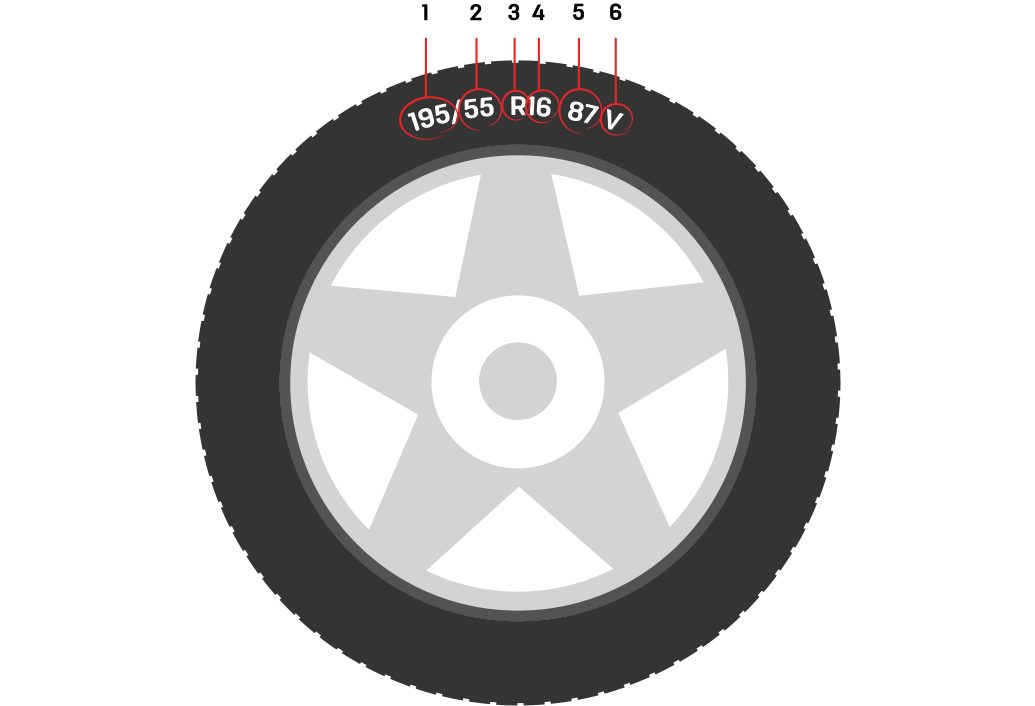
To the untrained eye, the side wall of a tyre can look like a meaningless set of numbers, letters and symbols. Hidden amongst these is the tyre size. But what does it look like and, more importantly, what does it mean?
Dissecting the code
The tyre size might read like this: P195/55 R16 87 V. Hardly user friendly but, when you know what it all means, you’ll realise it tells you useful information about the tyre’s construction, size and type.
 How the tyre size might appear.
How the tyre size might appear.
1 Cross section width
The first three numbers, in this case 195, refer to the section width of the tyre. This is the measurement, in millimetres, from the tyre’s inner sidewall to its outer sidewall.
2 Aspect ratio
The aspect ratio, or profile, refers to the height of the sidewall as a % of the section width. In our example, 55 means the height is equal to 55% of the 195mm width. The bigger the aspect ratio, the bigger the sidewall will be.
3 Construction type
The letter R means the tyre is a radial construction. Almost all new car tyres are radials.
4 Rim
The number to the right of the construction type is the rim diameter, measured in inches. In this case, it’s a 16” wheel.
5 Load index
The final number is the load index i.e. the maximum load (in kg) that the tyre can carry. See chart below
6 Speed symbol
The final character (in this case V) relates to the maximum speed of use. Again, the following table will clarify what your tyre’s symbol means.
| Load Index | Load in kg | Load Index | Load in kg | Load Index | Load in kg | Load Index | Load in kg |
| 62 | 265 | 79 | 437 | 96 | 710 | 113 | 1150 |
| 63 | 272 | 80 | 450 | 97 | 730 | 114 | 1180 |
| 64 | 280 | 81 | 462 | 98 | 750 | 115 | 1215 |
| 65 | 290 | 82 | 475 | 99 | 775 | 116 | 1250 |
| 66 | 300 | 83 | 487 | 100 | 800 | 117 | 1285 |
| 67 | 307 | 84 | 500 | 101 | 825 | 118 | 1320 |
| 68 | 315 | 85 | 515 | 102 | 850 | 119 | 1360 |
| 69 | 325 | 86 | 530 | 103 | 875 | 120 | 1400 |
| 70 | 335 | 87 | 545 | 104 | 900 | 121 | 1450 |
| 71 | 345 | 88 | 560 | 105 | 925 | 122 | 1500 |
| 72 | 355 | 89 | 580 | 106 | 950 | 123 | 1550 |
| 73 | 365 | 90 | 600 | 107 | 975 | 124 | 1600 |
| 74 | 375 | 91 | 615 | 108 | 1000 | 125 | 1650 |
| 75 | 387 | 92 | 630 | 109 | 1030 | 126 | 1700 |
| 76 | 400 | 93 | 650 | 110 | 1060 | ||
| 77 | 412 | 94 | 670 | 111 | 1090 | ||
| 78 | 425 | 95 | 690 | 112 | 1120 |
Tyre load rating table
| Speed Rating | Mile/Hour | Kilometers/Hour | Speed Rating | Mile/Hour | Kilometers/Hour | |
| N | 87 | 140 | U | 124 | 200 | |
| P | 93 | 150 | H | 130 | 210 | |
| Q | 99 | 160 | V | 149 | 240 | |
| R | 106 | 170 | ZR | 150+ | 240+ | |
| S | 112 | 180 | W | 168 | 270 | |
| T | 118 | 190 | Y | 186 | 300 |
Tyre speed rating table
Where can I find my car’s tyre size?
You’ll find you car’s tyre size on the tyres’ sidewall, in your car’s vehicle manual as well as on a sticker inside the driver’s door. If you’re still unsure, visit your nearest Uniroyal dealership for advice.
Related Topics
-
 2023/03/31Passenger car tyres are products of complex engineering. Learn more about the components that make up modern car tyres.Tyre componentsRead more
2023/03/31Passenger car tyres are products of complex engineering. Learn more about the components that make up modern car tyres.Tyre componentsRead more -
 2023/03/31Do you want to calculate the tyre size of your tyres? We explain the formula – find out more from Uniroyal. Find out more now!Rolling circumferenceRead more
2023/03/31Do you want to calculate the tyre size of your tyres? We explain the formula – find out more from Uniroyal. Find out more now!Rolling circumferenceRead more